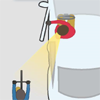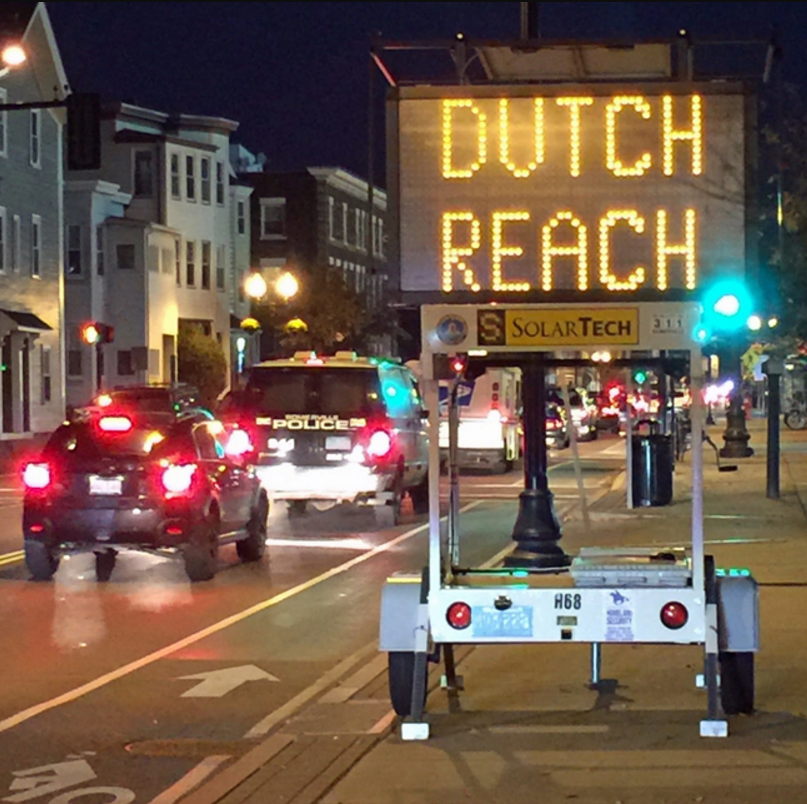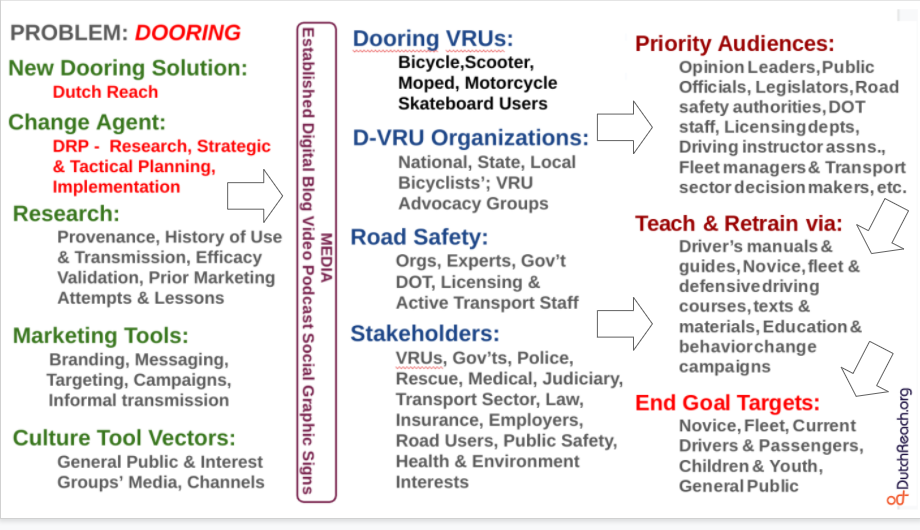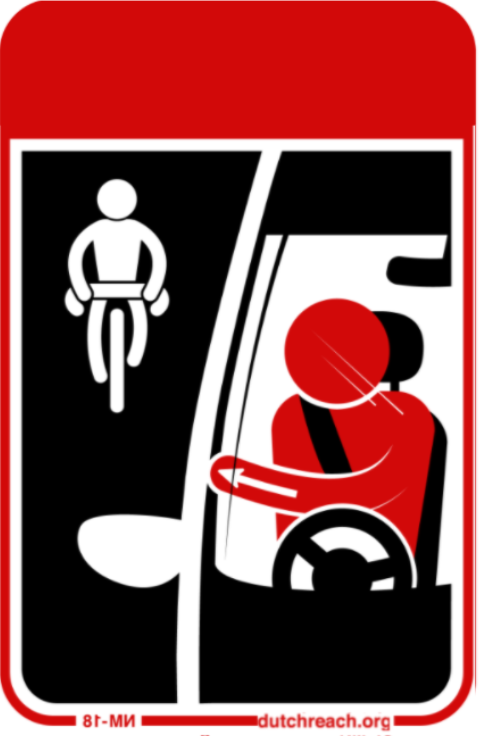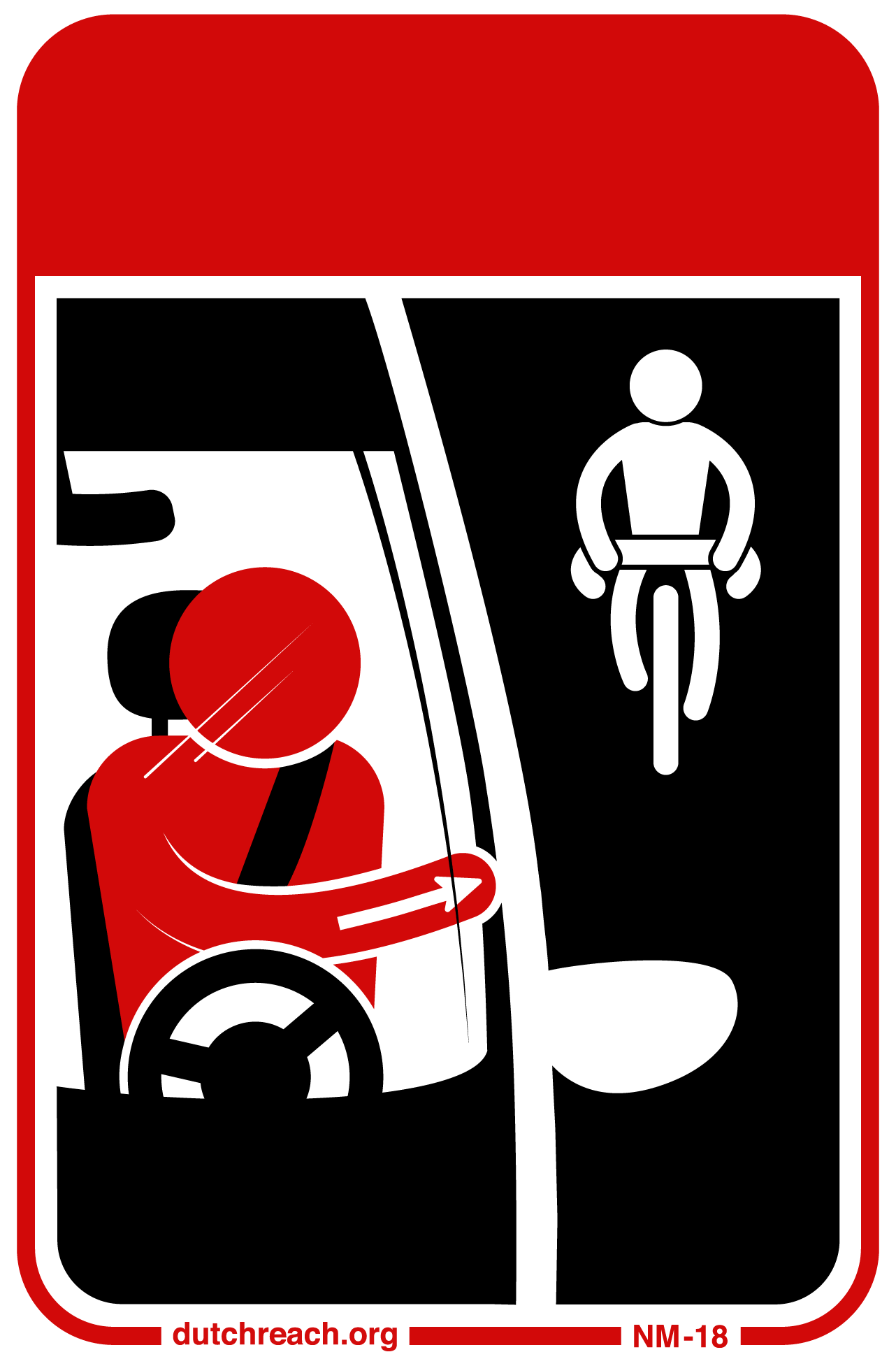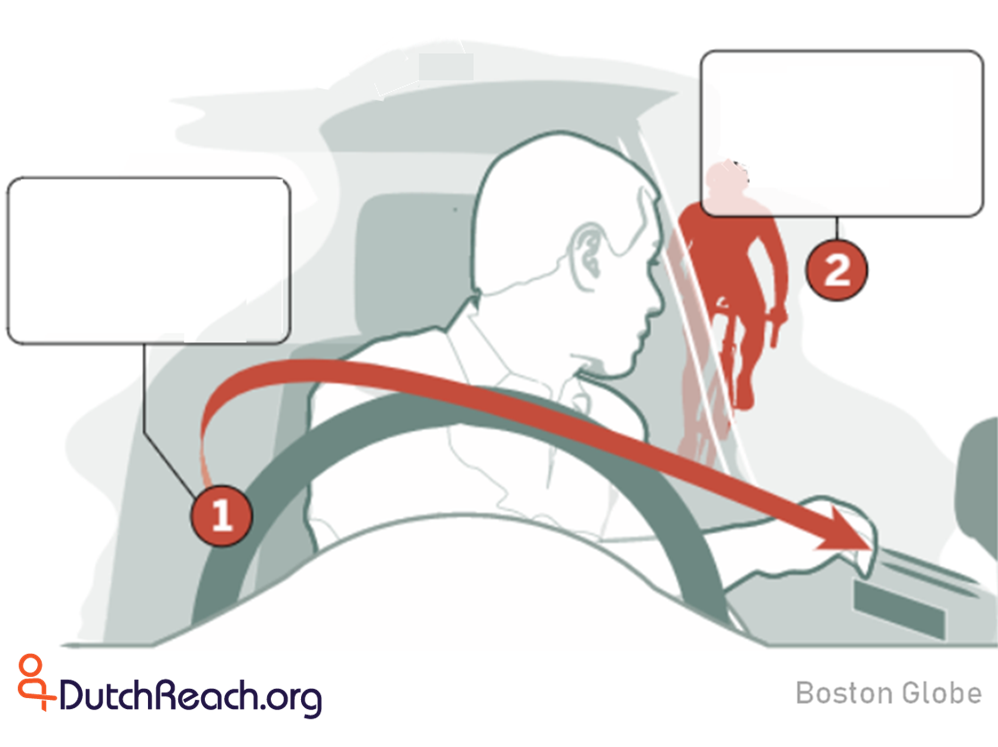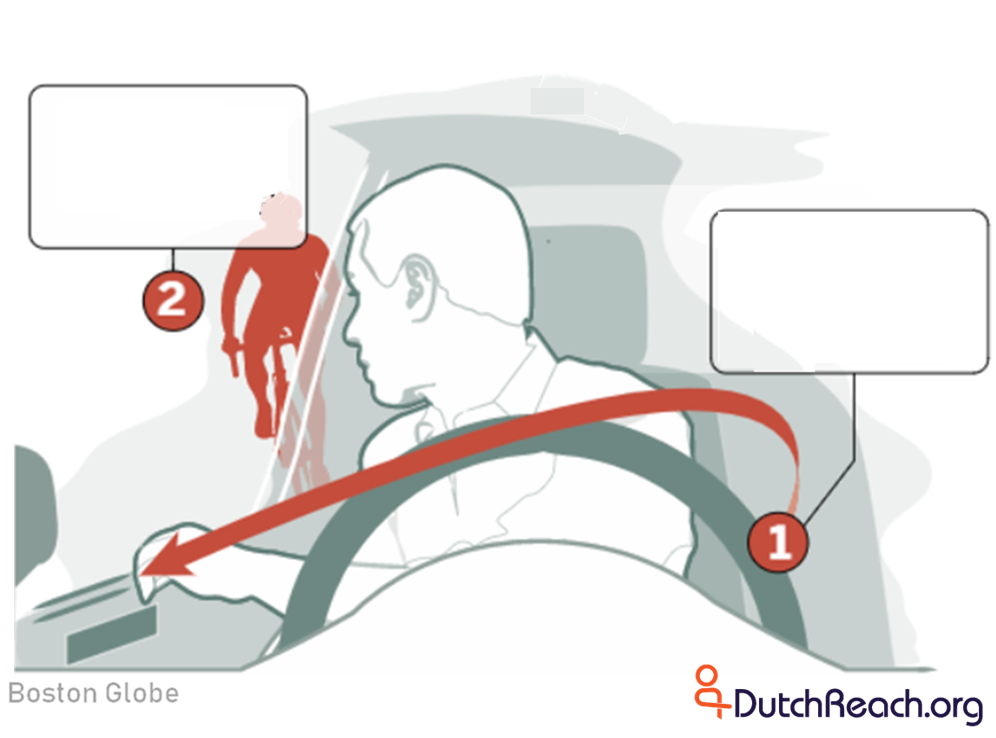'Do It Yourself' Dutch Reach Campaign
Several Korean university students wrote to this Project, requesting advice on how to start their own campaign. Here's our exchange - edited, expanded & still in progress.
Query:
Hello! We are cyclists and university students in Korea. We are planning to promote "Dutch reach" in Korea. But there is no specific information in Korea, so I am contacting you to ask for your help. .... could you do an interview with us?
Dutch Reach Project replies:
Greetings!
Yes I will be pleased to speak with you by Zoom or Skype if we can arrange a convenient time & date.
Are you aware, however, that the Dutch Reach Project has a website www.dutchreach.org ? There you can find the most comprehensive collection of information, advice & campaign graphics & videos on the far hand method.
The site is best viewed on a desktop, not on a smart-phone, as it is a 'static' old-style, amateur-run site. And please be patient as some pages are slow to load fully.
It is worth exploring all the drop down menu and pop-out menu pages. There you can find answers to many questions, discussions of issues, troves of examples, materials and resources for your use and inspiration.
Besides the universally useful web pages, you will find Dutch Reach media coverage in over 37 languages including Korean, and non-English videos in a dozen different languages - including several in Korean - at:
Menu bar> Media> Coverage by Country or Language
&
Menu bar> Videos> Foreign Languages
Five US driver's manuals now include sections on dooring danger and a Dutch Reach advisory. Most have one or more editions in other languages as well.
Go to Menu bar> Advocacy Toolkit> International Activity >Dutch Reach in Translation to find US states' official dooring & Dutch Reach advisories in multiple language editions. The State of Washington has 6 language editions including Korean. Its Dutch Reach advisory is found on page 3-27 (or p. 67 of the pdf).
Detailed information on the advantages of the far vs the near hand habit is found here Menu bar> Advocacy Toolkit> Working Papers> Officials Dutch Reach Instruction Guide
In Home> About you can find All Things Bike's video interview with me about the Dutch Reach Project & method or click and view it here.
And for a detailed explanation of the Dutch Reach Project, its history, tactics, strategy and successes, see the Case Study of the Dutch Reach Project here.
Also, Wikipedia in English has a good summary entry on the Dutch Reach here.
The Project site has graphics which you can adapt by adding Korean captions. I have attached an example in Korean which I found, but I can't tell how accurate it is. Also I have attached two 'blank' graphics to which you might add text. See the English language captions for these and other graphics at Menu bar>Advocacy Toolkit> Graphics, Flyers, Stickers (A)
I would be glad to insert your recommended Korean text into these blanks for you if you need graphics help. I have found one graphic in Korean but I don't know how accurate the caption is. [Please let me know if it is, for I rely on Google Translate to decipher and draft captions & hashtags in other languages.]
Any media coverage, graphics or videos which you create please share back to me so I can put them up on the website!
I have a question for you as well. Does the your highway code include rules against blocking a travel lane unsafely when parked or stopped in traffic? It is important that a rule about lane obstruction be included as it forms the legal basis to make dooring a violation. Most US states now include such provisions. The Dutch Reach is now being added as an advisory or something which may be required to be taught and tested for in the written licensing and/or road test examinations. See League of American Bicyclists on Dooring Law here.
I also welcome your suggestions and specific questions.
Yours truly,
University Students respond:
Wow! Thank you so much for all this information! Actually, none of us is good at English, so I think it will be difficult to use Skype or Zoom...(ㅠㅠ
First of all, there is a rule in Korea's highway regulations that blocks unsafe driving lanes when parking or stopping in traffic.
Yes! We also looked up various "Dutch reach" promotional videos and posts through Google. The same goes for the website www.dutchreach.org!
But the information we really want is
1. Why did you promote "Dutch reach"?
2. If you promoted "Dutch reach", how did you promote it? (Promotional video or text)
3. Was the public interested in the "Dutch reach" promotional material?
4. What do you think is essential to promoting "Dutch reach"? (What is the top priority when producing promotional material? )
5. Did "Dutch reach" have a promotional effect?
6. What are some ways to reduce the actual rate of opening accidents?
7. Do you think simply promoting "Dutch reach" is effective in reducing the rate of opening accidents?
8. What do you think is the most effective way to promote "Dutch reach" to countless drivers?
That's the information!
I want to know what you felt while promoting Dutch reach, such as how you went through the process and what difficulties you had in that process!
I'm really sorry for asking for so much information (ㅠㅠ) Also, we are not good at English and we are turning Papago, so if there is a rude expression among the above articles, we sincerely apologize.
Thank you so much for your answer! If we produce a Dutch Rich promotional video, we'll send it to you right away! Also, if you need any information, feel free to ask! I'll answer it right away!
Dutch Reach Project replies:
Greetings again!
First, I encourage you to find someone - a bicycle or road safety advocate would be best - who shares your ambition and who knows both English & Korean & can translate or explain the most important sections on the website or suggested materials. Or help edit and improve your own translations.
I recommend doing this self-education and consider starting your own webpage or Facebook or comparable Korean internet site where you can share Korean versions of Dutch Reach Project information and your own new content. This will become an important long term contribution to bike safety in Korea. Or if there already exists an active bicycle organization for ordinary bicyclists - city bicyclists, commuting bicyclists, recreational bicyclists - call and talk to them. Maybe they will help or even develop their own web-based campaign.
I would also like to learn more about you and your colleagues, and ask you why are you now interested in dooring prevention and bicycle safety. Was there a recent serious dooring crash? Is it a very frequent kind of crash where you live? Has someone been killed?
Also, how much time and effort can you devote to this and how large an impact do you hope to make in the time you have available as students?
Its now nearly six years since I begain this project. I've learned it is hard to change peoples' unsafe behavior - whether of bicyclists or motorists & passengers. But its worth trying.
Start small but start! - a slogan, a sticker, a small campaign, a local newspaper story, a poster campaign at your school or by talking to college or town officials about your issue & ideas, and learn from them as well.
If you can do a video, well and good, but it may be a lot of work with little online interest unless it is quite witty or powerful in some way. Even so, you will learn by trying and may eventually find what works in your community and culture. You could announce a graphic design or video contest on the subject with voting, prizes, awards and a video showing event, which will draw creative talent and widen public interest. There are many ways to start. But start!
Having a good sticker and slogan is very important. It gets attention and gives you opportunities to talk to people to get feedback, and become a better advocate yourself. As you learn more about messaging - how to make your message or pitch more effective - you will also get new ideas about how to spread your message, and find allies in the larger public of bicycle riders, bike organizations, government and non-governmental health & safety organizations which might pick up your message and promote it further. You will learn by doing and get better at it over time.
Basically though, promoting road safety or any behavior change is a form of social marketing. So speak to fellow students or professors who teach business marketing, or read books about other public health or safety behavior change campaigns, such as smoking prevention, distracted driving prevention, fire safety etc. which will give you ideas and strategies.
The biggest goal is to get the dooring prevention advice taught to student and already licensed drivers. This requires that it be adopted by government transportation officials in charge of licensing education and testing. Driving schools & instructors will then teach it. Transportation officials should also launch a sustained public education and behavior change campaign.
This will take time but you can plant the seeds quickly. Send letters, speak at hearings, meet with elected and apppointed offiicials. Once the situation is ripe, it may happen much faster than expected. Environmental & economic concern can also drive such action as biking is one of the best alternatives to cars in cities. But bikng need to be felt safe to become more popular.
As for your list of questions, almost all are answered somewhere on my website or in linked rticles, and in Menu bar>About I chonicled the Project's progress for the first few years.
As given in my first reply, the Dutch Reach Project's Case Study and the video interview by All Things Bike explain it all. The Case Study is the most authoritative summary of my project. It details the issues, history, tactics, strategy and progress made.
Now for your questions:
1. Why did you promote "Dutch reach"?
Read the Boston Globe's original story here. The National Safety Council did a good Q&A piece here as well.
2. If you promoted "Dutch reach", how did you promote it? (Promotional video or text)
After three months of research, outreach & preparation of materials, I first went public with the Project by sending suggested haiku-like texts to local police departments to post on electronic traffic signs. One department did and that triggered newspaper interest by the Boston Globe reporter above. That first story started a spontaneous wave of media interest and the creation of dozens of web stories, podcasts, videos and graphics which I found and posted on the DRP website. The initial video & media coverage was wonderful and soon went international.
The most effective video was the very first: The Dutch Reach: Safe For Work by Outside Online. They produced and posted it within two weeks of the Boston Globe story and it came as a complete surprise. It's now been viewed far more than 3.4 million times if you include the foreign language captioned versions.
Also in the first month, BBC/PRI interviewed me on air which was carried by hundreds of stations in North America.
3. Was the public interested in the "Dutch reach" promotional material?
Bicyclists were especially interested and have been the Project's best allies in spreading the message to begin with. But in countries where mopeds and motorbikes are dominant they might be more interested and helpful than bicyclists.
4. What do you think is essential to promoting "Dutch reach"? (What is the top priority when producing promotional material? )
A good slogan, a catchy phrase or name, a compelling graphic, evidence of the danger of dooring - unfortunately this is most often a tragic dooring death, a website, frequent graphic social media posts, and if you are very lucky, a viral video. You also need one or more articulate and well informed person to be your spokesperson.
Popular videos can't be made to order but if there is significant public concern, one may emerge or several professional Public Service videos produced by government agencies or road safety organizations may get made and distributed widely to their members and mainstream media outlets.
5. Did "Dutch reach" have a promotional effect?
In English the coinage is accurate and catchy to the ear. It goes well with Teach the Reach & Preach the Reach. It expresses the arm action and its Dutch provenance is itself a road safety endorsement. And like the novel word 'dooring' - which is the problem - 'Dutch Reach'was and still for most people a puzzling coinage. Furthermore "Dutch" in English has some socially questionable, negative or even crude associations. However I was unaware of this when I coined the term and only learned of it later. That said, its ambiguous connotations have definitely helped get publicity.
No doubt the name was a lucky stroke. How to translate it or create a name with buzz in other languages may be difficult. Both 'dooring' and 'Dutch Reach' have been adopted in some other languages if a good translation has not yet been found or coined.
Note: The Dutch Reach campaign itself does double service: It promotes this overlooked safety trick. It also educates the motoring public about "doorng" crashes, of which most drivers and passengers are woefully unaware.
6. What are some ways to reduce the actual rate of opening accidents?
Bicyclists should 'take the lane' and avoid the door zone. See under Resources> Dooring Self-defense for Cyclists
Drivers/Passenger: Use mirror & use the Dutch Reach to do a shoulder-check look back to view blind spot AS YOU OPEN and exit facing ttraffic; Never fling open door. Don't trust mirror alone. The far hand habit encourages multiple safety features as described in detail in the Officials Dutch Reach Instruction Guide.
Local Governments: Design & implement safe infrastructure for bicyclists & all vulnerable road users (VRUs). No more door zone bike lanes. If paint only, include 1 meter door-width buffer zones as well. Protected bike lanes on major arteries & streets. Remove parking ie 'car storage' to make room for jprotected bikepaths, and encourage mass transit, walking, car free inner cities etc.
State Governments: Improve driver education and license testing to protect vulnerable road users & sharing the road. Increase enforcement and penalties for driver negligence causing injury & death; reduce motor vehicle speeds on roads & streets in cities especially. Follow Dutch, Danish & Swedish examples in driver training & infrastructure. etc.
Technology: Mandate Vulnerable Road User detection & dooring prevention technologies in new model vehicles, mirrors or rear passengers & other inventions. See Menu bar> Tech Solutions to Doorings
7. Do you think simply promoting "Dutch reach" is effective in reducing the rate of opening accidents?
Road safety experts in the Netherlands, the United Kingdom, Canada, the U.S., Germany, Australia, New Zealand and other countries, in government and in major road safety organizations endorse the far hand measure for safe egress as it includes both mirror check and shoulder-check of blind spot before and as one exits.
I have detailed the many specific advantages of the method over the near hand push or fling method in the Official Dutch Reach Instructional Guide, and explained the inherent flaws in the near hand method as well.
When the opposite hand method is used, it works. Getting drivers & motorists to swap habits is the challenge.
As far as I have determined, prior to my Project no road safety study ever compared the near versus the far hand habit for safety value on egress. For the Dutch the safety advantages of the far hand habit have been self-evident, as it is for virtually all driving instruction experts who have tried it.
Only with the popularization of Dutch Reach - and rising awareness of dooring danger - have a few human factors safety researchers begun to devise and publish (small), laboratory-based pilot studies of particular aspects of this question. Real world studies will be very desireable but will be very difficult to design & excute. As it is, dooring statistics themselves are very little collected by most all government authorities, and often are bunched in with 'side collisions' and 'overtaking collisions', neither of which might distinguish the role of a dooring or swerve into traffic to avoid a flung door.
Recognition of doorings toll of life, limb and property has not been properly appreciated in most first world countries. This is beginning to change as more people use bicycles, e-bike or other active transportation devices for personal transport, health, exercise, environmental benefit or economic reasons - and get nearly doored or actually injured, and fear its daily risk.
In developing countries however, mopeds and motorcyclists often equal private auto users in numbers. There doorings of vulnerable moped, scooter & motorcyclists are a far larger problem. But the true toll of doorings of motered bikes is not yet known. What statistics I have found thus far are at Menu bar> Research> Dooring Statistics here.
8. What do you think is the most effective way to promote "Dutch reach" to countless drivers?
Get local, state, national government agencies to promote & teach it, requiring it in drivers education & licensing, involving national road safety organizations etc.
Obtain or Demand keeping of statistics on types & consequences & costs of VRU v Motor vehicle crashes to argue for policy changes.
Build your VRU / Bike/Walk/ Active transportation advocacy groups. Learn how bike and other road safety advocacy groups have made progress in your own country and around the world.
Once you have educated yourselves in the issues & solutions, seek an appointment or phone conversation with local officials etc. to raise your concerns & recommendations.
Reply & New Query by Students
Oh... I am so sorry ㅠㅠ I was not able to contact you because I am still a student because of preparing for the exam. I'm so sorry...
First of all, your answer was very helpful!! Thank you so much for letting us know the information we don't get!
First of all, we decided to make a card news to promote "Dutch reach"! Afterwards, we will look at the promotional effect and produce a video.
Is there any essential element for us to make card news? I wonder if there are any phrases or images that must be included in the card news other than "A good slogan, a catchy phase or name, a compiling graphic, evidence of the danger of door." that you mentioned before!
Also, is there any other information that can help us? Thank you so much for your kind and prompt reply as always!
I hope you always have a happy time and full of luck.
Dutch Reach Project Reply
Hello again!
Your delay is not a problem for me. I understand that you are students. Doing well in your studies and exams should be your first priority.
I am confident that you will be able to find sufficient examples on my website to copy and imitate to help you make reasonably good graphics and text.
It is a very good learning experience for you to create several versions of graphics or other media and show the drafts to friends, family and strangers to get their feedback.
It may be best that you start out to get fellow students and bicyclists or moped users interested first. Showing your draft examples to them will let you quickly find out what works best for them in terms of graphics and language. Motor bike users and bicyclists will be your best helpers to 'talk it up" and share it it as they/ we are most concerned and at risk.
Every nation and unique language has its own culture and special meanings and associations of words. Your challenge is to translate the Dutch far hand door opening method message so it is accurate and if possible memorable, using word choice, word sounds and word associations & choice of images. Your goal is that it "sells" itself to the people you are hoping to influence.
And you don't have to use the word "Dutch' or "reach" if you can think of something better! Challenge one another to come up with other phrases.
In English - before I came up with "Dutch Reach" - other road safety activists tried out phrases like: Opposite Hand Trick, Cross Check, Far Hand Reach, Amsterdam Method. These names for the same thing haven't caught on and may never win out. So far "Dutch Reach" has pushed them to the side. But also I have been much more active promoting "Dutch Reach" than they had or have been promoting their names for it.
Some road safety authorities in government or organizations may insist on a very descriptive name, such as "Far Hand Reach" in English, as has the National Safety Council here in the US. That's how they name it in their video and Defensive Driving Courses & textbook. But so far it too hasn't caught on much at all on social media.
In German the Dutch grip - Der hollandishe Griff - has become standard. In French they have tried the Pivot Opening - L'ouverture pivot - as well as several other phrases. It will be some time I think before the French settle on a standard name.
I recently came across a translation from Chinese into English which comes out as "Dutch touch." I don't know if that was a good or only a literal translation, but if so, perhaps it will work well in Chinese for some cultural or word choice reason.
You may end up using a "Dutch ___ " adjectival phrase or convert 'Dutch Reach' to a homophone in Korean, or just use a literal translation of "Dutch Reach" as is if it's already getting established in Korea. But if you can come up with a witty, catchy name in Korean it may win out. Over time, popular usage will decide it, just like with slang.
Also, you will be doing "social marketing" and need to think about your target audience. They may be ordinary or professional drivers, learning drivers, passengers, fellow students, mothers concerned about their child's safety, old or young etc. This may affect your choice of graphics or text if and when you develop your campaign further.
I would be pleased to comment on any materials you develop regarding accuracy but your own judgment and creativity is most important.
Good luck on your exams!
Best,
Project Strategy Chart & Explanation
Dutch Reach Project Strategy Chart. Click image to enlarge.
DRP will introduce the Dutch anti dooring countermeasure into public road safety culture & established driver education & training programs.
Strategic plan proceeds from left to right.
Left column: DRP develops research, resources & capacities to educate & influence important constituencies.
Vertical bar & Middle column: Outreach to constituencies is made either directly or via electronic media transmission & amplification.
Arrows & Right column: Persuaded allies & interest groups then promote the Dutch Reach directly to motorists, or lobby key decision makers & institutions to endorse, promote & teach the far hand Dutch method using their established educational means.
DRP will then gather relevant news, media reports & new resources (graphics, videos, campaign ideas & materials etc.) making these available on the project website & also rebroadcast by the Project using social media.
A virtuous cycle of awareness, capacity, advocacy & progress will be generated as the Dutch Reach meme & Project spread to additional geographic & linguistic populations with anti-dooring need.
-- Published in Dutch Reach Project Case Study, Observatory of Public Sector Innovation, Organisation for Economic Co-operation and Development, 2020.
